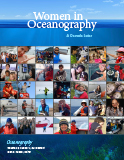Full Text
Fifteen years ago as the millennium was drawing to a close, a group of us (the author, a Web designer, and a writer) decided that the time was right to introduce a new website highlighting the contributions that women make to marine science. We envisioned a site where students considering careers in oceanography could read about the experiences of successful women and learn from the choices they made. Such a site would convey the excitement of groundbreaking research in oceanography and serve as a resource for teachers, scientists, and the general public. Finally, we wanted a site that would commemorate the achievements of a group of remarkable women and bring a human face to those working in marine science.
In the fall of 1999, we received a grant from the US National Science Foundation's "Awards to Facilitate Geoscience Education" to make this site a reality, and in the winter of 2000, we launched Women in Oceanography (http://www.womenoceanographers.org). Five years later, our site contained the profiles of 15 women, each with a unique story to tell. Even though funding ran out, I continue to host the site on an external server, and 15 years later, Women in Oceanography remains available to those interested in reading about the diverse career paths in marine science.
Lessons Learned
As our website came together and evolved, we found that it does more than celebrate the achievements of the scientists. It provides a realistic view of their professions and the challenges they face while pursuing their careers. The site also demonstrates that there are no typical scientists or career paths. With each profile completed, we learned something new and gained new perspectives on marine science. For example, we found that the women had varied interests and have faced different challenges, and they have made unique contributions to the study of oceanography and to our knowledge of Earth and its ocean.
One of the most rewarding aspects about this experience was that, without exception, each woman was extremely cooperative and generous with her time. All of the women shared the goal of making the site a worthwhile, entertaining, and educational experience for users, and they all spent a significant amount of time working with us. Before each of the women was interviewed, we sent a list of questions we planned to ask. During the interviews, which generally lasted about two hours, we discussed the research or other work each woman was engaged in, and then moved to the question and answer portion. The entire interview was videotaped, and following the interviews, Edwin Schiele, the science writer, wrote the introduction and edited the question and answers. I wrote the "Learn More" lessons. Each woman was asked to review and comment on what we had written, and they were invited to provide photographs, write their calendars, and provide links to publications and other relevant sites. In hindsight, their generosity with their time was remarkable.
Although we can infer that many of the people entering our site are interested in oceanography, we have no way of determining what percentage are students, teachers, scientists, or interested members of the general public. Nor do we have any quantitative measure of whether our site has influenced any students, although several middle school students have contacted one of the profiled women to interview her for a school science project. These have been very positive experiences for the women, with only one exception when an overzealous parent became too involved in the project. The profiled women referred colleagues and potential students to the site. And we heard anecdotally from other scientists that they often visited the site, and were especially interested in the weekly calendars to see how colleagues balance their time.
One of the biggest challenges was publicizing the site. We contacted a number of organizations and urged them to add links to our site from their websites. In March 2000, the American Geophysical Union's Eos Transactions published a favorable review of our site, doubling the traffic in the days following publication. In June 2000, the site was listed as one of the San Francisco Exploratorium's "Ten Cool Sites."
Based on Web statistics, we knew early on that much of our traffic came through the Woods Hole Oceanographic Institution's home page, the Stanford University marine website, and other school websites. These links no longer exist, and the site is found primarily through web searches. The top Google search phrases leading to our site include women scientists, oceanographers, marine biologists, oceans, and oceanography.
Personally, I find the site just as compelling and usable today as I did 10 years ago. And current Web statistics suggest that people are still visiting the site with as many as 30 unique visitors per day, even though the site is no longer promoted. If resources were available, I would update the careers of each of the women to show where their jobs have led them over the last decade, but for now and as long as the site continues to attract users as is, my plan is to keep it active.

